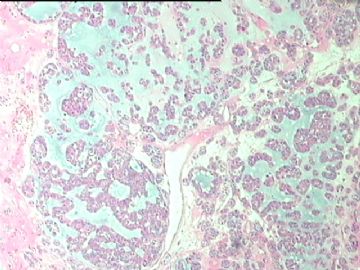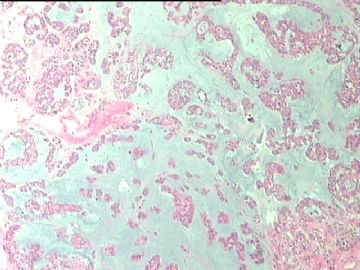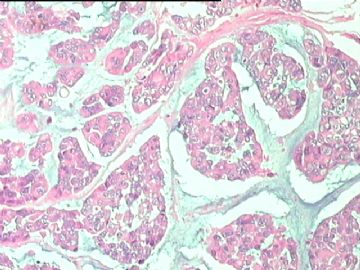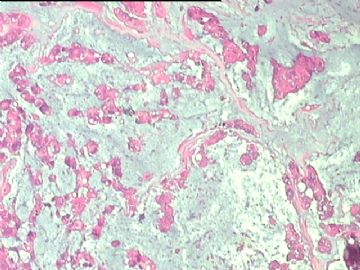| 图片: | |
|---|---|
| 名称: | |
| 描述: | |
- B2469男性乳腺肿物
| 姓 名: | ××× | 性别: | 男 | 年龄: | 59岁 |
| 标本名称: | 右乳腺肿物 | ||||
| 简要病史: | 右乳腺外上象限一肿物1*0.8cm. | ||||
| 肉眼检查: | 灰白碎组织二小块,无包膜,共1*0.8*0.3cm,全一片。 | ||||
相关帖子
- • 边界清楚的乳腺包块
- • 右乳肿块,新加免疫组化结果
- • 乳癌类型?
- • 乳腺肿块,请会诊
- • 左侧乳腺外上象限肿物,髓样癌?
- • 乳腺肿块
- • 女,29岁,发现右乳肿块,停止哺乳后手术切除肿块
- • 请求老师会诊,34岁女,乳腺肿物。
- • 乳腺癌类型?
- • 乳腺微创手术活检,诊断?
-
lantian0508 离线
- 帖子:1250
- 粉蓝豆:42
- 经验:1495
- 注册时间:2007-08-01
- 加关注 | 发消息
-
本帖最后由 于 2010-01-21 05:10:00 编辑
This is one of the largest male breast carcinoma study from AFIP. cz
Virchows Arch. 2006 Nov;449(5):507-12. Epub 2006 Oct 13.
Invasive carcinomas of the male breast: a morphologic study of the distribution of histologic subtypes and metastatic patterns in 778 cases.
Burga AM, Fadare O, Lininger RA, Tavassoli FA.
Department of Gynecologic and Breast Pathology, Armed Forces Institute of Pathology, Washington, DC, USA.
The current investigation was conducted to evaluate the proportional distribution of the various histologic subtypes (including newly recognized variants) of male breast carcinomas, to determine whether any histologic subtypes occur with a frequency that is markedly discordant with the expected frequencies from published data on parallel female breast tumors. We also aimed to document the distribution of malignancies metastatic to the breast. Seven hundred fifty-nine archived cases of primary invasive carcinoma involving the male breast were retrieved and sub-categorized into histologic subtypes according to contemporary criteria. Six hundred forty-three (84.7%) tumors were pure infiltrating ductal carcinoma (IDC) not otherwise specified. The most common of the remainder included papillary carcinoma with invasion in the form of IDC (n = 34), mixed IDC and mucinous carcinoma (n = 26), and pure mucinous carcinoma (n = 21). In 19 cases, metastases from other sites involved the breast, most commonly (58%) cutaneous melanoma. Invasive carcinoma of the male breast appears to display a morphologic spectrum and distribution of histologic subtypes that is comparable to those of the female breast, with some expected variation. Compared with published experience on their female counterparts, there is a two-fold increase in the frequency of invasive papillary carcinoma in the male breast. Finally, the most common tumor metastatic to the male breast in this series was cutaneous melanoma.
Gac Med Mex. 2007 Jan-Feb;143(1):79-81.
[Pure mucinous (colloid) carcinoma of the male breast. An uncommon subtype]
[Article in Spanish]
Martínez-Consuegra N, Baquera-Heredia J, Robles-Vidal C, Zumarán-Cuéllar O, Ortiz-Hidalgo C.
Departamento de Patología, Centro Médico ABC, Mexico, DF Mexico.
Pure mucinous (colloid, mucous) carcinoma of the male breast is an extremely rare neoplasm. We report the case of a 74-year-old male who displayed a rapidly growing retroareolar tumor of the left breast. The patient underwent modified radical mastectomy. The tumor was well demarcated, had a soft consistency with a glistening gelatinous appearance. Histologically, the neoplasm corresponded to a pure mucinous carcinoma which is one of the most unusual subtYpes, accounting for less than 2% of male breast carcinomas.
Breast Cancer. 2009 Sep 10. [Epub ahead of print]
Pure mucinous carcinoma with axillary lymph node metastasis in a male breast.
Dragoumis DM, Assimaki AS, Tsiftsoglou AP.
Breast Division, Department of General Surgery, St Luke's Hospital, Panorama, 55 236, Thessaloniki, Greece, ddragoumis@gmail.com.
Pure mucinous carcinoma of the male breast is an extremely uncommon malignant breast neoplasm and usually occurs at advanced age. It is characterized by a higher degree of mucus production, a more benign behavior, a lower incidence of metastatic nodal involvement, and a subsequent higher survival rate. We describe such a case of a 59-year-old male, who displayed a gradually growing retroareolar tumor of the right breast. The tumor was well demarcated and had a soft consistency with a gelatinous appearance. Based on the preoperative clinical identification of right axillary lymphadenopathy, the patient eventually underwent right modified radical mastectomy and right axillary nodal dissection. Regarding histological findings, the neoplasm corresponded to a pure mucinous carcinoma with axillary lymph node metastasis. Although lymph node metastasis of pure mucinous carcinoma of the breast is rare, it is essential to perform careful clinical examination when the primary breast mass is suspicious for mucinous carcinoma, because the presence of axillary lymphadenopathy will subsequently define the proper choice of therapeutic strategy.




























